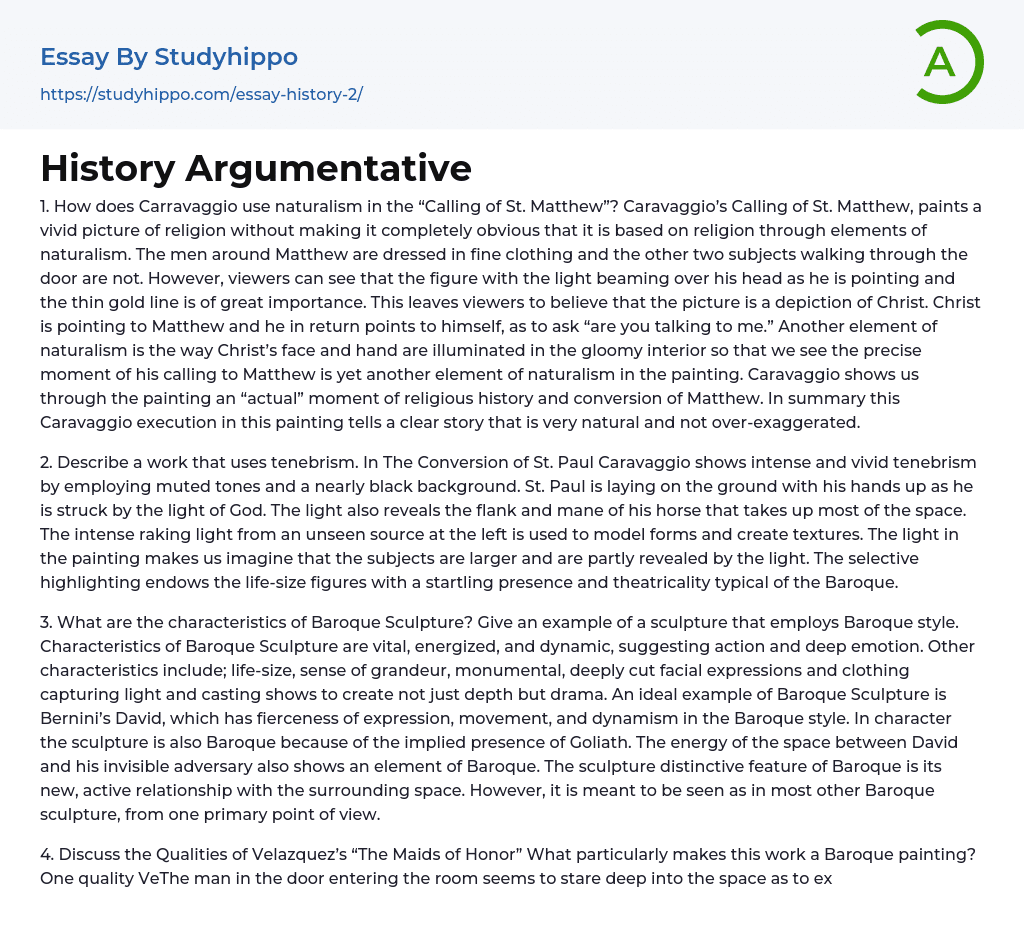1. Caravaggio's "Calling of St. Matthew" exemplifies the use of naturalism in its portrayal of religion, displaying elements that imply religious symbolism without explicitly depicting it. Notably, the painting contrasts the well-dressed men surrounding Matthew with two figures at the door, indicating their significance. The figure with a halo and pointing gesture, along with a thin gold line, implies he represents Christ. This can be inferred as he points towards Matthew while Matthew points towards himself, suggesting his questioning if the message is meant for him. Additionally, Christ's illuminated face and hand amidst the dim interior capture the precise moment of Matthew's calling. Caravaggio's artwork offers an authentic representation of Matthew's conversion - a historical religious event - conveying a genuine and understated narrative.
2. The Conversion of St. Pau
...l by Caravaggio showcases tenebrism through the use of muted tones and a nearly black background. St. Paul is depicted laying on the ground with his hands raised, as the light of God strikes him. The light also illuminates the flank and mane of his horse, which dominates most of the composition. By employing intense raking light from an unseen source, Caravaggio creates texture and molds the forms. This lighting technique also conveys a sense of magnification and partial revelation of the subjects. Focusing on selective highlights, the painting gives the life-size figures a striking presence and theatricality commonly associated with the Baroque period.
3. Baroque Sculpture is known for its vitality, energy, and dynamism that evoke action and deep emotion. It is characterized by life-size representation, grandeur, and monumentality. This style features deeply cut facial expressions and clothing that captur
light, creating dramatic shadows to enhance depth perception. One notable example of Baroque Sculpture is Bernini's David, which exemplifies fierceness of expression, movement, and dynamism. The sculpture also conveys the essence of the Baroque period through its portrayal of the implied presence of Goliath and the energetic space between David and his unseen adversary. Another distinguishing feature of Baroque Sculpture is its active relationship with surrounding space. Like most other works in this style, it is intended to be viewed from a single primary viewpoint.
4. This text discusses the qualities of Velazquez's "The Maids of Honor". One characteristic that classifies this artwork as Baroque is the man in the doorway who appears to be observing things with a deep gaze, creating a sense of distance despite the small area depicted. This utilization of space exemplifies a common spatial value in Baroque art. In addition, Velazquez draws attention to the court through his use of light, making it the focal point. Moreover, all the figures in the painting seem to be directing their gaze towards the viewer, contributing to the immersive storytelling aspect typical of Baroque style. Tenebrism, characterized by darker tones in the background and light on the royal court, plays a significant role in Velazquez's work and enhances its Baroque qualities by emphasizing the significance of the court.
5. The Baroque period is most associated with ceiling paintings, although other periods also produced them.
6. (10 points) Two Baroque architects, Carlo Maderno and Gian Lorenzo Bernini, worked on St. Peter's Cathedral. Carlo Maderno was the first, and after his death, Gian Lorenzo Bernini took over.
- Creativity essays
- Art History essays
- Theatre essays
- Pastoral essays
- Visual Arts essays
- Postmodernism essays
- Symbolism essays
- ballet essays
- Color essays
- Modernism essays
- Mona Lisa essays
- Work of art essays
- Body Art essays
- Artist essays
- Cultural Anthropology essays
- Ethnography essays
- Aesthetics essays
- Realism essays
- Heritage essays
- Harlem Renaissance essays
- Concert Review essays
- Voice essays
- Theatre Of The Absurd essays
- Playwright essays
- Scotland essays
- Tennessee williams essays
- Design essays
- Graffiti essays
- Graphic essays
- Typography essays
- Painting essays
- Photography essays
- Sculpture essays
- Architecture essays
- Interior design essays
- Arch essays
- Area essays
- Tattoo essays
- Pablo Picasso essays
- Vincent Van Gogh essays
- Michelangelo essays
- Frida Kahlo essays
- Russian Empire essays
- Ancient Greece essays
- British Empire essays
- Historical Figures essays
- Nazi Germany essays
- Roman Empire essays
- War essays
- Revolution essays




